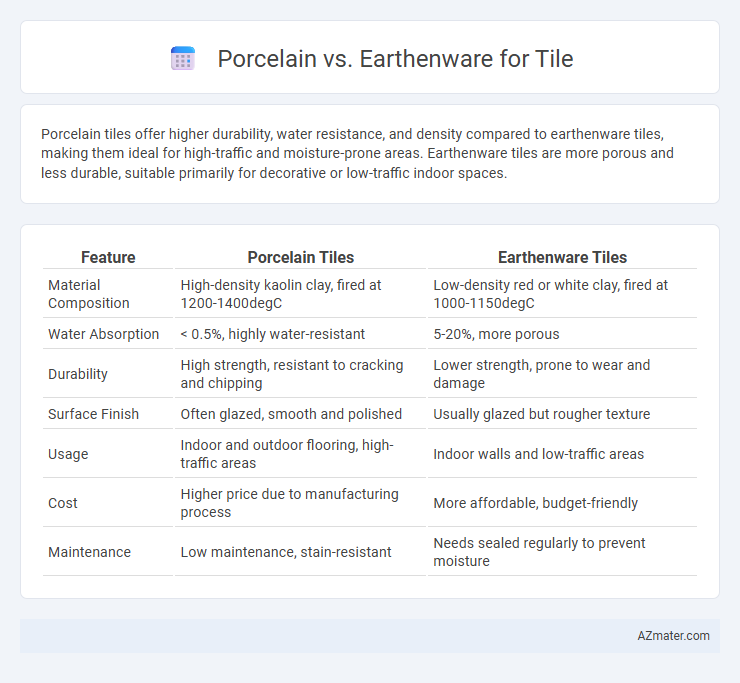Porcelain tiles offer higher durability, water resistance, and density compared to earthenware tiles, making them ideal for high-traffic and moisture-prone areas. Earthenware tiles are more porous and less durable, suitable primarily for decorative or low-traffic indoor spaces.
Table of Comparison
| Feature | Porcelain Tiles | Earthenware Tiles |
|---|---|---|
| Material Composition | High-density kaolin clay, fired at 1200-1400degC | Low-density red or white clay, fired at 1000-1150degC |
| Water Absorption | < 0.5%, highly water-resistant | 5-20%, more porous |
| Durability | High strength, resistant to cracking and chipping | Lower strength, prone to wear and damage |
| Surface Finish | Often glazed, smooth and polished | Usually glazed but rougher texture |
| Usage | Indoor and outdoor flooring, high-traffic areas | Indoor walls and low-traffic areas |
| Cost | Higher price due to manufacturing process | More affordable, budget-friendly |
| Maintenance | Low maintenance, stain-resistant | Needs sealed regularly to prevent moisture |
Understanding Porcelain and Earthenware Tiles
Porcelain tiles are made from refined clay baked at higher temperatures, resulting in a denser, more durable, and water-resistant surface ideal for high-traffic and moisture-prone areas. Earthenware tiles are crafted from porous clay fired at lower temperatures, making them less durable and more absorbent, suited for decorative or low-traffic spaces. Understanding these differences helps in selecting the right tile based on durability requirements, water resistance, and aesthetic preferences.
Composition and Manufacturing Differences
Porcelain tiles are made from a refined clay mixture that includes kaolin and fired at higher temperatures around 1200-1400degC, resulting in a dense, non-porous structure. Earthenware tiles use coarser clay with added natural minerals and are fired at lower temperatures between 1000-1150degC, which produces a more porous and less durable material. The composition and firing techniques directly influence porcelain's superior hardness and moisture resistance compared to the more absorbent and softer earthenware.
Appearance and Design Options
Porcelain tiles offer a sleek, polished appearance with a wide range of colors, patterns, and finishes that mimic natural stone, making them ideal for modern and high-end designs. Earthenware tiles present a rustic, warm look with matte or satin finishes, often featuring handcrafted details and earthy tones that complement traditional or Mediterranean styles. Both tile types provide versatile design options, but porcelain's density allows for more intricate designs and sharper edges, enhancing aesthetic precision.
Durability and Strength Comparison
Porcelain tiles exhibit higher durability and strength compared to earthenware due to their dense, vitrified composition and low porosity, which makes them resistant to chipping, cracking, and moisture absorption. Earthenware tiles, crafted from a more porous clay fired at lower temperatures, are more prone to wear, scratches, and water damage, making them less suitable for high-traffic or wet areas. The superior hardness of porcelain tiles, often rated higher on the Mohs scale, ensures longer-lasting performance in both residential and commercial applications.
Water Absorption and Stain Resistance
Porcelain tiles exhibit significantly lower water absorption rates, typically less than 0.5%, compared to earthenware tiles, which can absorb up to 10%. This low porosity makes porcelain highly stain-resistant and ideal for moisture-prone areas such as bathrooms and kitchens. Earthenware's higher porosity requires sealing to prevent staining and water damage, limiting its use in high-moisture environments.
Suitable Applications and Ideal Locations
Porcelain tiles, known for their high density and low porosity, are ideal for high-traffic areas such as commercial spaces, bathrooms, and kitchens due to their durability and water resistance. Earthenware tiles, being more porous and less dense, suit low-traffic indoor applications like decorative walls, patios, and areas with limited moisture exposure. For outdoor use in harsh climates, porcelain offers superior frost resistance, making it the preferred choice for exterior flooring and pool surrounds.
Installation Challenges and Considerations
Porcelain tiles, known for their density and low porosity, require specialized tools and techniques such as diamond blades for precise cutting and a strong adhesive for secure installation, making the process more labor-intensive compared to earthenware tiles. Earthenware tiles are softer and more porous, allowing for easier cutting and handling, but they demand careful sealing to prevent moisture absorption and damage over time, impacting maintenance post-installation. Proper subfloor preparation and moisture barriers are critical for both materials to ensure durability, with porcelain tiles offering greater resistance to wear and moisture, ideal for high-traffic or wet areas.
Maintenance and Longevity
Porcelain tiles offer superior durability and low maintenance due to their dense, non-porous surface, making them resistant to stains, scratches, and moisture. Earthenware tiles require more frequent sealing and careful cleaning to prevent damage and absorb moisture, which can shorten their lifespan. Porcelain generally outperforms earthenware in longevity, often lasting decades with minimal upkeep.
Cost and Value Analysis
Porcelain tiles generally come at a higher initial cost compared to earthenware due to their denser composition and superior durability, making them ideal for high-traffic areas requiring long-lasting performance. Earthenware tiles offer a more budget-friendly option but tend to be less resistant to moisture and wear, which may result in higher replacement or maintenance expenses over time. Evaluating porcelain versus earthenware involves balancing upfront investment against long-term value, with porcelain providing greater longevity and potential cost savings in maintenance and durability.
Eco-Friendliness and Sustainability
Porcelain tiles offer higher durability and lower porosity, resulting in longer lifespan and reduced replacement frequency, which enhances sustainability compared to earthenware. Earthenware tiles require more frequent maintenance and tend to absorb moisture, leading to shorter usability and increased environmental impact over time. Choosing porcelain supports eco-friendliness by minimizing waste and conserving resources through its superior strength and low water absorption properties.

Infographic: Porcelain vs Earthenware for Tile
 azmater.com
azmater.com